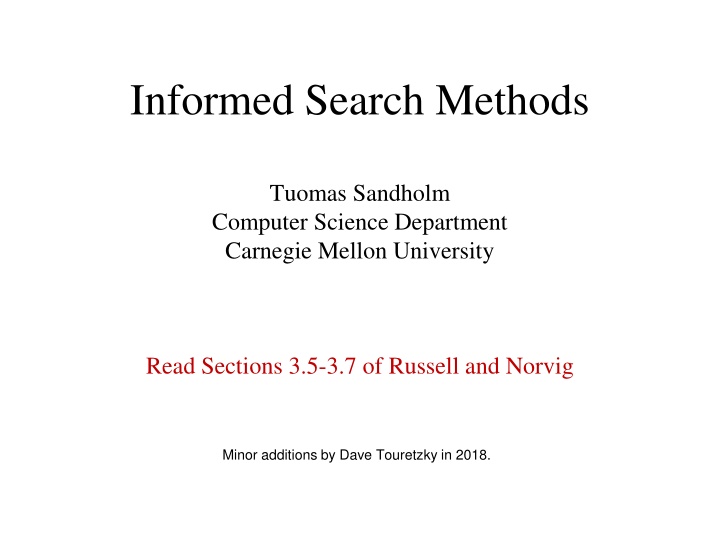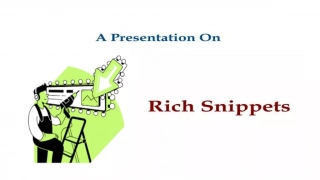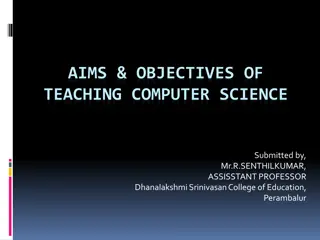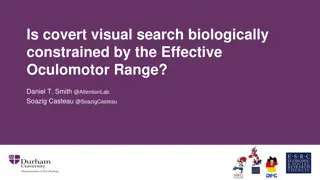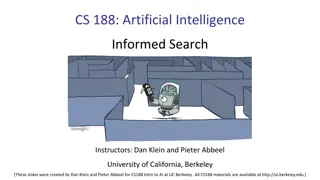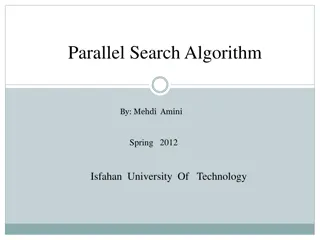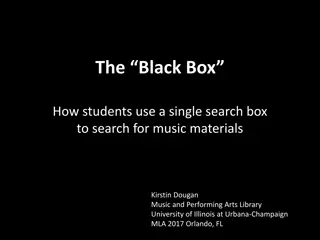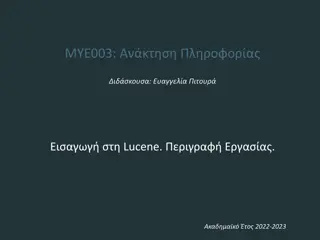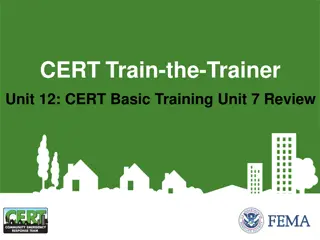Overview of Informed Search Methods in Computer Science
Detailed exploration of informed search methods in computer science, covering key concepts such as heuristics, uninformed vs. informed search strategies, Best-First Search, Greedy Search, Beam Search, and A* Search. Learn about different algorithms and their applications to solve complex problems efficiently.
Download Presentation

Please find below an Image/Link to download the presentation.
The content on the website is provided AS IS for your information and personal use only. It may not be sold, licensed, or shared on other websites without obtaining consent from the author.If you encounter any issues during the download, it is possible that the publisher has removed the file from their server.
You are allowed to download the files provided on this website for personal or commercial use, subject to the condition that they are used lawfully. All files are the property of their respective owners.
The content on the website is provided AS IS for your information and personal use only. It may not be sold, licensed, or shared on other websites without obtaining consent from the author.
E N D
Presentation Transcript
Informed Search Methods Tuomas Sandholm Computer Science Department Carnegie Mellon University Read Sections 3.5-3.7 of Russell and Norvig Minor additions by Dave Touretzky in 2018.
Heuristic Literally translates to to find , to discover Has many meanings in general How to come up with mathematical proofs Opposite of algorithmic Rules of thumb in expert systems Improve average case performance, e.g., in CSPs Algorithms that use low-order polynomial time (and come within a bound of the optimal solution) % from optimum % of cases probably approximately correct h(n) that estimates the remaining cost from a state n to a solution We ll assume that for all n, h(n) 0, and for all goal nodes n, h(n)=0. 2
Uninformed vs. Informed Search Uninformed Can only generate successors and distinguish goals from non-goals Informed Strategies that know whether one non-goal is more promising than another 3
Best-First Search function BEST-FIRST-SEARCH (problem, EVAL-FN) returns a solution sequence inputs: problem, a problem EVAL-FN, an evaluation function Queuing-Fn a function that orders nodes by EVAL-FN return GENERAL-SEARCH (problem, Queuing-Fn) An implementation of best-first search using the general search algorithm. Usually, knowledge of the problem is incorporated in an evaluation function that describes the desirability of expanding the particular node. If we really knew the desirability, it would not be a search at all. So, we should really call it seemingly best-first search to be pedantic. In UCS, the EVAL-FN is path cost, i.e., cost to reach this node . In Best First Search, the EVAL-FN is estimated distance to the goal. 4
Greedy Search function GREEDY-SEARCH (problem) returns a solution or failure return BEST-FIRST-SEARCH (problem, h) h(n) = estimated cost of the cheapest path from the state at node n to a goal state Not Optimal Incomplete O(bm) time O(bm) space Let h(n) = straight line distance from the city at node n to the goal. 5
Beam Search Use f(n) = h(n) but |nodes| K (beam width) Focuses on a few best candidates Avoids exponential time and space costs Not complete Not optimal 6
A* Search In a minimization problem, an admissible heuristic h(n) never overestimates the real cost. (In a maximization problem, h(n) is admissible if it never underestimates the real value.) So admissible heuristics are optimistic. Best-first search using f(n) = g(n) + h(n) and an admissible h(n) is known as A* search. A* tree search is complete & optimal. 7
A* Search function A*-SEARCH (problem) returns a solution or failure return BEST-FIRST-SEARCH (problem, g+h) f(n) = estimated cost of the cheapest solution through n = g(n) + h(n) = path cost + heuristic estimate of distance to go f=291+380 =671 f=291+380 =671 8
Completeness of A* Because A* expands nodes in order of increasing f, it must eventually expand to reach a goal state. This is true unless there are infinitely many nodes with f(n) f*. How could this happen? There is a node with an infinity branching factor. There is a path with finite path cost but an infinite number of nodes on it. So, A* is complete on graphs with a finite branching factor provided there is some positive constant such that every operator costs at least . 9
Proof of optimality of A* tree search Assumes h is admissible, but does not assume h is monotonic Let G be an optimal goal state, and f(G) = f* = g(G). Let G2be a suboptimal goal state, i.e., f(G2) = g(G2) > f*. Suppose for contradiction that A* has selected G2from the queue. This would terminate A* with a suboptimal solution. Let n be a node that is currently a leaf node on an optimal path to G. Situation at the point where a sub-optimal goal state G2is about to be picked from the queue f(n) f(G2)= g(G2) f* Because h is admissible, f* f(n). If n is not chosen for expansion over G2, we must have f(n) f(G2). So, f* f(G2). Because h(G2)=0, we have f* g(G2), contradiction. 10
Consistency of a heuristic h(n) is consistent (aka. monotonic) if, for every node n and every child n of n generated by any action a, the estimated cost of reaching the goal from n is no greater than the step cost of getting to n plus the estimated cost of reaching the goal from n : h(n) c(n,a,n ) +h(n ). Consistency implies that f(n) (which equals g(n)+h(n)) never decreases along a path from the root. Consistent => admissible Advanced topic: A* Search with Inconsistent Heuristics in Proceedings of the International Joint Conference on Artificial Intelligence (IJCAI), 2009, provides techniques for making non-monotonic heuristics monotonic With a consistent heuristic, we can interpret A* as searching through contours: Map of Romania showing contours at f = 380, f = 400 and f = 420, with Arad as the start state. Nodes inside a given contour have f-costs lower than the contour value. 11
Consistency of a heuristic A* expands all nodes n with f(n) < f*, and may expand some nodes right on the goal contour (f(n) = f*), before selecting a goal node. With a consistent (monotonic) heuristic, even A* graph search (i.e., search that deletes later-created duplicates) is optimal. Another option, which requires only admissibility, not consistency, is to have the duplicate detector always keep the best (rather than the first) of the duplicates. A* tree search doesn t do detection or removal of duplicates. 12
A* graph search is optimal if h is consistent (admissibility does not suffice) See proof in Russell & Norvig book p. 95-97. 13
Complexity of A* Generally O(bd) time and space. Absolute error: = h(n) - h*(n) Sub-exponential growth when |h(n) - h*(n)| O(log h*(n)) Unfortunately, for most practical heuristics, the error is at least proportional to the path cost 14
A* is optimally efficient A* with a consistent heuristic is optimally efficient for any given h-function among algorithms that extend search paths from the root. I.e., no other optimal algorithm is guaranteed to expand fewer nodes (except perhaps on the goal contour where f(n)=f*) (for a given search formulation). With an inconsistent admissible heuristic, some nodes can be expanded many times, causing the search to do O(2N) node expansions, where N is the number of nodes expanded Intuition: any algorithm that does not expand all nodes in the contours between the root and the goal contour runs the risk of missing the optimal solution. 15
Heuristics (h(n)) for A* A typical instance of the 8-puzzle Heuristics? h1: #tiles in wrong position h2: sum of Manhattan distances of the tiles from their goal positions h2dominates h1: n, h2(n) h1(n) 17
Heuristics (h(n)) for A* Comparison of the search costs and effective branching factors for the ITERATIVE- DEPENING-SEARCH and A* algorithms with h1, h2. Data are averaged over 100 instances of the 8-puzzle, for various solution lengths. 18
Inventing heuristic functions h(n) Cost of exact solution to a relaxed problem is often a good heuristic for original problem. Relaxed problem(s) can be generated automatically from the problem description by dropping or relaxing constraints. Most common example in operations research: relaxing all integrality constraints and using linear programming to get an optimistic h-value. What if no dominant heuristic is found? h(n) = max [ h1(n), hm(n) ] h(n) is still admissible & dominates the component heuristics Use probabilistic info from statistical experiments: If h(n)=14, h*(n)=18 . Gives up optimality, but does less search Pick features & use machine learning to determine their contribution to h. Use full breadth-first search as a heuristic? search time complexity of computing h(n) 19
PATTERN DATABASES FOR HEURISTICS [Culberson & Schaeffer 1996; many improvements since; figures in this segment borrowed from others AI courses] 20
Combining multiple pattern databases (counting moves of all tiles) (counting moves of all tiles) Overall heuristic value is the maximum of these, that is, 31. 21
Additive pattern databases Original pattern databases counted all moves (include moves of pieces not in the pattern) to get pattern pieces into their correct places Additive pattern databases count only moves of the pieces belonging to the pattern and optimize that Manhattan distance is a special case where each piece is its own pattern Then, can add the values of the different patterns instead of taking the max Why? Because having other pieces on the board cannot reduce the number of pattern-piece moves that are needed to get pattern pieces in their right places 22
Example: 7-8 pattern database Note: It doesn t matter for correctness how one partitions the tiles into disjoint sets for the pattern database. 23
Computing the heuristic value in an additive pattern database (counting only moves of red tiles) (counting only moves of blue tiles) 24
Performance 25
Dynamic pattern databases In the database generation phase, use multiple different partitions of the tiles. In the search phase, in any given search state that is reached, when computing the h-value, try different partitions and pick one that gives the highest h-value. 26
General template for pattern databases for any application A pattern is an assignment of values to a subset of the variables in the problem The database is built via a breadth-first search backward from the goal until each pattern has been observed at least once (Need to make sure that one move does not help variables in multiple patterns; otherwise cannot add in that part.) 27
Memory-bounded search algorithms
Iterative Deepening A* (IDA*) function IDA*(problem) returns a solution sequence inputs: problem, a problem static: f-limit, the current f-COST limit root, a node root MAKE-NODE(INITIAL-STATE[problem]) f-limit f-COST(root) loop do solution, f-limit DFS-CONTOUR(root,f-limit) if solution is non-null then return solution if f-limit = then return failure; end function DFS-CONTOUR(node,f-limit) returns a solution sequence and a new f-COST limit inputs: node, a node f-limit, the current f-COST limit static: next-f, the f-COST limit for the next contour, initially if f-COST[node] > f-limit then return null, f-COST[node] if GOAL-TEST[problem](STATE[node]) then return node, f-limit for each node s in SUCCESSOR(node) do solution, new-f DFS-CONTOUR(s,f-limit) if solution is non-null then return solution, f-limit next-f MIN(next-f, new-f); end return null, next-f f-COST[node] = g[node] + h[node] 29
A* vs. IDA* visited 3x visited 2x visited 1x Map of Romania showing contours at f = 380, f = 400 and f = 420, with Arad as the start state. Nodes inside a given contour have f-costs lower than the contour value. 30
Question: When is IDA* a good idea? A. When the branching factor is small B. When the branching factor is large 31
IDA* Complete & optimal under same conditions as A*. Linear space. Same O( ) time complexity as A*. If # nodes grows exponentially, then asymptotically optimal space. 32
IDA* Effective e.g. in 8-puzzle where f typically only increases 2-3 times 2-3 iterations. Last iteration ~ A* Ineffective in, e.g., TSP where f increases continuously each new iteration only includes one new node. If A* expands N nodes, IDA* expands O(N2) nodes Fixed increment ~1/ iterations Obtains -optimal solution if terminated once first solution is found Obtains an optimal solution if search of the current contour is completed 33
Memory-bounded search algorithms }use too little memory IDA* 1985 Recursive best-first search 1991 Memory-bounded A* (MA*) 1989 Simple memory-bounded A* (SMA*) 1992 34
Simple Memory-bounded A* (SMA*) Progress of SMA* (with enough memory to store just 3 nodes). Each node is labeled with its current f-cost. Values in parentheses show the value of the best forgotten descendant. Search space A f = g+h = goal 13(15) A A A 12 12 13 A G 0+12=12 13 10 8 B G B B G 15 10+5=15 8+5=13 18 H 15 13 10 10 8 16 C D H I A 15(15) A A 20+5=25 16+2=18 15(24) 20(24) 20+0=20 24+0=24 8 A 10 10 8 8 15 B B E F J K G 15 20( ) 24( ) 30+5=35 24+5=29 24+0=24 30+0=30 B G 25 I D 15 24 C 24 20 Optimal & complete if enough memory Can be made to signal when the best solution found might not be optimal (e.g., if J=19) 35
Local Search 37
Hill Climbing Evaluation function assigns a value to each state. Each state has a set of neighbors a small distance away. We only care about finding a goal state, not the path. Hill Climbing search method -- greedy local search: maintain a single best state look only at the neighbors of the current best state select the best neighbor if it s better than or equal to the current best state stop when all neighbors are worse than current best 38
Hill Climbing in 8 Queens Best neighbors of current state (h=17) have h=12. Local minimum state: h=1, and every neighbor has h > 1. Random-restart hill climbing: if plateau is reached, pick new start state at random and search again. Can solve 3,000,000 queens in < 1 minute! But NP-hard problems have lots of local maxima, so failure rate can be prohibitively high. Hill climbing can fail if the state space isn t monotonic. 40
Stochastic Gradient Descent If we re minimizing error instead of maximizing value, hill climbing is called gradient descent. Can get stuck in local minima. Stochastic gradient descent = gradient descent with (some) uphill moves. Take the best downhill direction if possible. Else select an uphill move with some probability p based on how far uphill. 41
Simulated Annealing How tolerant should we be of uphill moves? Simulated annealing: Temperature parameter T governs willingness to move uphill. High T = big uphill moves allowed. Low T = only small uphill allowed. Start at high T and gradually lower it. Analogous to annealing in metallurgy. High probability of finding global minimum if we anneal slowly enough. 42
Uses of Simulated Annealing VLSI layout optimization Place chip modules to minimize wire length. A move might swap two modules. Boltzmann Machines: neural networks whose units have binary states. Energy is a function of the weights between pairs of active nodes. Use simulated annealing to find minimum energy states. 43
Other Local Search Methods Local beam search Generate k random starting states. At each step, find all successors and take the k best ones. Genetic algorithms Maintain a population of candidates. Generate new candidates by a combination of crossover and random mutation. Crossover combines parts of two parent states to make a successor state. 44
Additional Slides (not required for this lecture) 46
Approximate A* versions (less search effort, but only an approximately optimal solution) 1. Dynamic weighting: f(n) = g(n) + h(n) + [1- (depth(n) / N)] h(n) where N is (an upper bound on) depth of desired goal. Idea: Do more focused search early on in the search. Thrm: Solution is within factor (1+ ) of optimal. 1. A *: From open list, choose among nodes with f-value within a factor (1+ ) of the most promising f-value. Thrm: Solution is within factor (1+ ) of optimal Make the choice based on which of those nodes leads to lowest search effort to goal (sometimes picking a node with best h-value accomplishes this) 47
Best-bound search A* search was invented in the AI research community Best-bound search was invented in the operations research community Same node selection strategy as A* but for a different setting: not a given graph to search as in A*, but integer programming where one can decide which variable to branch on at every point in the search tree (like in CSPs) In practice, not exactly A* node selection is used. With heavy-to-compute h-heuristics such as LP, commercial integer programming solvers: Use parent s f value to queue nodes on the open list, and only evaluate nodes exactly if they come off the open list => first solution may not be optimal => need to continue the search until all nodes on the open list look worse than the best solution found Do diving. In practice there is usually not enough memory to store the LP data structures with every node. Instead, only one LP table is kept. Moving to a child or parent in the search tree is cheap because the LP data structures can be incrementally updated. Moving to another node in the tree can be more expensive. Therefore, when a child node is almost as promising as the most-promising (according to A*) node, the search is made to proceed to the child instead. Again, need to continue the search until all nodes on the open list look worse than the best solution found 48
